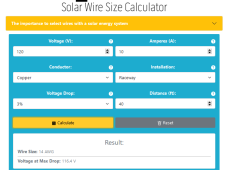Hi, I am installing an off grid generator on my boat. I have three (3) 400W panels, planning to connect them in series. Each panel produces a max of about 40V and 10A. The wire run from my panels to my MPPT solar controller will be about 40 feet. My solar controller will be charging a bank of 24V LFP batteries. What wire size should I run from my panels to the controller? The calculators I’ve tried give me 6 gauge, but that seems like overkill, or isn’t it?
You are using an out of date browser. It may not display this or other websites correctly.
You should upgrade or use an alternative browser.
You should upgrade or use an alternative browser.
Wire gauge recommendation for solar panels to controller
- Thread starter Awsmits
- Start date
WYtreasure
It's not happy hour, I'm just like this.
120 volts, 10 Amps, 40 feet is what I understood. Did I miss something?
 solarwiresizecalculator.com
solarwiresizecalculator.com

The Solar Wire Size Calculator

Standard 2.5mm twin insulated wire can take 16A easily, I've wired my panels using that, and it works perfectly.
(9x 340W panels in series, max current so far has been 7.5A, panels suggest max current possible 9.5A)
If it's outside in the weather run it through a plastic pipe, as the insulation becomes brittle in the sun.
Bend the stripped wire to 3x or 4x thickness so it crimps properly in the MC4 connectors.
(9x 340W panels in series, max current so far has been 7.5A, panels suggest max current possible 9.5A)
If it's outside in the weather run it through a plastic pipe, as the insulation becomes brittle in the sun.
Bend the stripped wire to 3x or 4x thickness so it crimps properly in the MC4 connectors.
chrisski
Solar Boondocker
- Joined
- Aug 14, 2020
- Messages
- 5,208
I’d consider running 10 awg to the first panel, and either 12 awg or 14 awg after that. for a 40’ run, could be worth the extra money to me if i had was even slightly thinking of adding more panels down the road. Anywhere on the 10 awg, I’d be able to splice in a parallel string. I’m starting to look at all blank spaces as a place to put a solar panel.
I have a related question Awsmits said that 3 panels at 40v each were going to be wired in series. That results in 120v which allows for a smaller wire diameter to be used because of the higher voltage. That’s how I understand it. My question is related to that combination of panels to achieve higher voltage. What if the panels under perform as in partial shade or dim conditions. Is it possible that a voltage drop could occur that could overheat wires?
I’m in a similar situation combining 3 panels with a VMP of 33.5 in series for 100V at 10 amps that need to run 260 feet to Mppt. I’m concerned about overheating cable if I base wire size on 100v and 10 amps if that could ever drop voltage based on performance.
I’m in a similar situation combining 3 panels with a VMP of 33.5 in series for 100V at 10 amps that need to run 260 feet to Mppt. I’m concerned about overheating cable if I base wire size on 100v and 10 amps if that could ever drop voltage based on performance.
The panels are not going to produce as much power in the shade; the amperage drops along with the voltage.
When figuring wire size, be sure to include the wire length as a round trip. Some calculators automatically figure it as a round trip and some do not.
When figuring wire size, be sure to include the wire length as a round trip. Some calculators automatically figure it as a round trip and some do not.
YOu may also find this voltage drop calculator useful. In the description, it states distance one way. voltage drop calcThanks for the explanation and advice. I used calculator above in the thread and arrived at 8 awg.
Standard household wiring (2.5mm twin insulated (14awg?)) is rated for minimum constant 16A @ 450V.I have a related question Awsmits said that 3 panels at 40v each were going to be wired in series. That results in 120v which allows for a smaller wire diameter to be used because of the higher voltage. That’s how I understand it. My question is related to that combination of panels to achieve higher voltage. What if the panels under perform as in partial shade or dim conditions. Is it possible that a voltage drop could occur that could overheat wires?
I’m in a similar situation combining 3 panels with a VMP of 33.5 in series for 100V at 10 amps that need to run 260 feet to Mppt. I’m concerned about overheating cable if I base wire size on 100v and 10 amps if that could ever drop voltage based on performance.
My opinion is that consumers overthink solar wiring, and the suppliers make a lot of money from selling you expensive stuff you don't really need.
Yes, you'll get a voltage drop over that distance, no, it doesn't really matter and isn't significant.
Just my opinion.
Rule of thumb for solar is <3% voltage drop. Do not know where, or who this comes from, just the number that is most often quoted.Standard household wiring (2.5mm twin insulated (14awg?)) is rated for minimum constant 16A @ 450V.
My opinion is that consumers overthink solar wiring, and the suppliers make a lot of money from selling you expensive stuff you don't really need.
Yes, you'll get a voltage drop over that distance, no, it doesn't really matter and isn't significant.
Just my opinion.
Similar threads
- Replies
- 8
- Views
- 250
- Replies
- 1
- Views
- 106
- Replies
- 39
- Views
- 848


